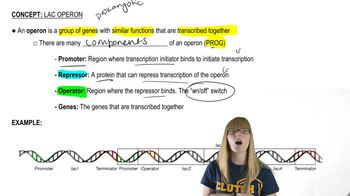What are the advantages and disadvantages of using GFP versus lacZ as a reporter gene in mice, C. elegans, and Drosophila?
Table of contents
- 1. Introduction to Genetics51m
- 2. Mendel's Laws of Inheritance3h 37m
- 3. Extensions to Mendelian Inheritance2h 41m
- 4. Genetic Mapping and Linkage2h 28m
- 5. Genetics of Bacteria and Viruses1h 21m
- 6. Chromosomal Variation1h 48m
- 7. DNA and Chromosome Structure56m
- 8. DNA Replication1h 10m
- 9. Mitosis and Meiosis1h 34m
- 10. Transcription1h 0m
- 11. Translation58m
- 12. Gene Regulation in Prokaryotes1h 19m
- 13. Gene Regulation in Eukaryotes44m
- 14. Genetic Control of Development44m
- 15. Genomes and Genomics1h 50m
- 16. Transposable Elements47m
- 17. Mutation, Repair, and Recombination1h 6m
- 18. Molecular Genetic Tools19m
- 19. Cancer Genetics29m
- 20. Quantitative Genetics1h 26m
- 21. Population Genetics50m
- 22. Evolutionary Genetics29m
12. Gene Regulation in Prokaryotes
Lac Operon
Problem 1c
Textbook Question
What led researchers to conclude that a repressor molecule regulates the lac operon?
 Verified step by step guidance
Verified step by step guidance1
Understand the lac operon: The lac operon is a set of genes in bacteria responsible for metabolizing lactose. It includes structural genes (lacZ, lacY, lacA), a promoter, an operator, and a regulatory gene (lacI). The lacI gene produces a repressor protein that binds to the operator to inhibit transcription.
Review experimental evidence: Researchers observed that in the absence of lactose, the lac operon is not expressed, suggesting a regulatory mechanism. When lactose is present, the operon becomes active, indicating that lactose interacts with the regulatory system.
Examine the role of the repressor: Mutations in the lacI gene led to constitutive expression of the lac operon, meaning it was active regardless of lactose presence. This suggested that the lacI gene product (the repressor) is necessary to inhibit operon expression in the absence of lactose.
Analyze the effect of lactose: Researchers found that lactose (or its derivative, allolactose) binds to the repressor molecule, causing a conformational change that prevents the repressor from binding to the operator. This allows RNA polymerase to transcribe the operon genes.
Conclude the regulatory mechanism: Based on these observations, researchers concluded that the lac operon is regulated by a repressor molecule produced by the lacI gene. The repressor binds to the operator to block transcription, and lactose acts as an inducer by inactivating the repressor.
 Verified video answer for a similar problem:
Verified video answer for a similar problem:This video solution was recommended by our tutors as helpful for the problem above
Video duration:
26sPlay a video:
Was this helpful?
Key Concepts
Here are the essential concepts you must grasp in order to answer the question correctly.
Lac Operon
The lac operon is a set of genes in bacteria, specifically E. coli, that are involved in the metabolism of lactose. It consists of structural genes that encode proteins necessary for lactose uptake and breakdown, and it is regulated by a promoter and an operator. Understanding the lac operon is crucial for grasping how bacteria adapt to different energy sources and how gene expression is controlled in response to environmental changes.
Recommended video:
Guided course

Lac Operon Overview
Repressor Molecule
A repressor molecule is a type of protein that binds to specific DNA sequences, inhibiting the transcription of certain genes. In the context of the lac operon, the lac repressor binds to the operator region, preventing RNA polymerase from transcribing the downstream genes when lactose is absent. This mechanism is a key example of negative regulation in gene expression, demonstrating how cells conserve resources by only expressing genes when necessary.
Recommended video:
Guided course

Trp Repressor
Gene Regulation Mechanisms
Gene regulation mechanisms refer to the various processes that control the timing and amount of gene expression in an organism. In bacteria, these mechanisms include operons, repressors, and activators, which respond to environmental signals. Understanding these mechanisms is essential for explaining how researchers deduced the role of the repressor in the lac operon, as they illustrate the dynamic interactions between genes and their regulatory elements.
Recommended video:
Guided course

Review of Regulation
Related Videos
Related Practice
Textbook Question
741
views


